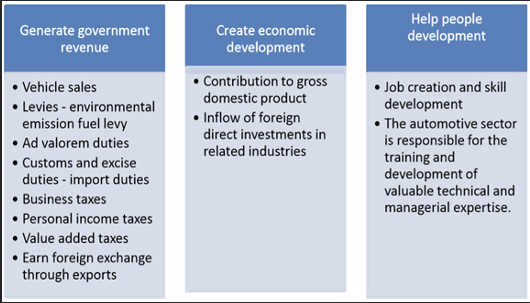Creative marketing and sales strategies are the generation and implementation of original messages communicated in an inventive way. This makes a message more memorable, raises brand recognition and the result is increased sales. Creativity then is the secret to outsmarting the competition. In this way the company hopes to create “customer value” and achieve “profitable customer relationships.”
The automobile part manufacturers (APM) are the firms that build parts which are used in the manufacturing of a vehicle. In the marketing strategy, companies determine, in their communication plan, the clients they represent, this segmentation and targeting, as well as how they serve their clients, which is differentiation and positioning.
A company’s marketing policy reflects its overall business strategy, its vision, its mission, and its values. In essence, a company’s marketing policy is a combination of deliberately organised and planned steps and the informal decision making and management. (Belz and Peattie, 2009)
Although South Africa has the potential to become a large vehicle parts producer, most vehicle manufacturers import much of their components from international APMs outside of the country. This is due to the instability of the industry which is because of high rates of HIV amongst the population/workers, a weak education system and a labour union militancy. Due to these reasons and compared to APMs in other parts of the world, South Africa must be creative in their marketing and sales of excellent quality parts at affordable rates when supplying local products to the automobile manufacturers. The automobile sector plays such a significant role in the South African economy and as such it is critical that this sector expands and that local automobile manufacturers procure a larger percentage of their parts from local APMs.
The South African Automotive Industry and its Economic Importance
The South African automotive industry is the third largest sector in the economy and is seen as the barometer to the economic health of the country. In the automobile production of Volkswagen, BMW, Nissan, General Motors, Ford, Mercedes – Benz and Toyota, South Africa has developed a major automotive industry (Van der Merwe and Visser, 2018). Consequently, there has been significant growth in the number of locally focused car product manufacturers (APMs). The government has recognised the automotive industry as a key growth industry while significantly raising the domestic content. According to the National Association of Automotive Manufacturers of South Africa (NAACAM, 2014), the country accounted for 76% of automotive production on the African continent in 2012. In 2015, 333 802 motor vehicles were sold to more than one hundred countries by South African vehicle manufactures (Whitfield, 2016). The automotive industry in South Africa comprises the world’s largest manufacturing base, producing the sixth largest in the world (Nag et al., 2017; OICA, 2018). In the emergent economies of North and East Asia, South America, and Eastern Europe and in South Africa, the sector is a significant one in several advanced developed countries (Nag, et. al., 2017). The automobile industry is also of enhanced significance. While less than 1% of the world’s motor vehicles are manufactured in South Africa, the local car market, which involves car parts manufacturers, is considered large. Whitfield (2016) states that in 2015, about 115,000 highly skilled workers were engaged in the manufacturing of cars and components; the automotive sector added approximately 7.5% to the country’s gross domestic product (GDP); it was responsible for 33.5% of the global manufacturing industry. A wide range of automotive parts manufactured in South Africa are exported for the aftermarket and as replacement parts to most countries in Africa. The total exports of automobiles to Africa (vehicles and automotive parts) increased significantly by 53.6% (R6.2 billion) in 2011 and to R17.8 billion in 2012 (NAACAM, 2014).
The automobile component manufacturers play a critical role in the creation of employment and make a major contribution to the country’s economy. The automotive industry also assists people with valuable expertise in areas such as design, fabrication, supply chain, marketing and sales and research and development. It generates substantial foreign exchange revenues, which is essential in terms of the current account of the nation and the trade balance with other trading partners. Foreign direct investments in production facilities and machinery which have increased the productivity and quality of motor vehicles and components to international standards also contribute positively to the automotive industry. The car industry also contributes to public income in the form of personal revenue taxes, business taxes, taxes such as the environmental emission tax on carbon dioxide, import duties and value-added taxes (NAACAM, 2014).
The role of the automotive industry to the economy in South Africa is illustrated below.
The Automotive Industry and its role in show casing South Africa to the world
South Africa became a democratic country in 1994 and the scheduled liberalisation of South Africa’s automotive industry began in 1995. This culminated in a free market for the South African car sector without any export barriers. This also led to the original equipment maker (OEM) no longer being forced to buy from local components producers (Black, 2019). The automotive parts manufacturers in South Africa have suffered huge economic problems because of their rapid exposure to international competition. Liberalising the South African automobile sector contributed to local companies purchasing technologies and adapting to satisfy local demands (Black, 2019). The industry was forced to obtain the latest technology since their exposure to the international arena. The latest technology was launched in 2009. At a more basic point, businesses produced manufactured goods utilising established combinations of machinery, competency, specifications, and organisational structures. However, many organisations did not see the need to upgrade their machinery and equipment given their limited production capacity. To do this, businesses needed skills to integrate emerging technologies into organisations. Those skills also became crucial to the ongoing access to external technology and to move closer to the global frontier in technology (Worku and Muchie, 2013).
The Challenges of the South African Automotive Industry
The South African car compound development sector faces some of the most complex and demanding conditions from a regional point of view. In the intensely competitive markets, the South African automobile parts manufacturers have become actively successful worldwide but have had to face problems such as:
- Clear market competition and time savings.
- Improvements in quality and overall client service.
- Significant decrease in the product life cycles, environment friendly products.
- The quick launch of new products.
- A lowering in production time and market costs
- The demands to access different customers both in terms of globalisation and emerging goods.
- Relationship improvement.
Due to the growing number of models in different countries, the management of the automotive parts manufacturers aimed for both growth and cost savings to make their businesses competitive and profitable. The automotive manufacturing parts industry is challenged to remain in the market, to manufacture at competitive prices and respond to world market demands quickly and reliably.
In certain situations, the lines of contact between the original equipment maker and other supply chain stakeholders remain manual. According to Kehbila, Ertel, and Brent (2019) this is particularly valid, as small suppliers are unable to afford the electronic data Interchange (EDI) technology between the original equipment maker and their larger suppliers.
The Nature of Marketing and Sales for Automotive Parts Manufacturers
Automotive parts manufacturers acquire business from importers and local manufacturers. Some of the local manufacturers are Ford Motor Corporation of Southern Africa, Toyota, VW, Nissan, Daimler and BMW and importers are Peugeot, Tata, Kia, and Hyundai. These manufacturers sell their signature franchises to the automobile parts manufacturers and these APMs are retained by these franchises if they comply with clear content and service requirements. Client reviews are measured by Customer Satisfaction index (CSI) ratings for customer loyalty. Revenues are constantly rising so to monitor general service efficiency the above metrics must be in place (Berndt and Herbst, 2015).
However, the atmosphere for any APM offering automobile parts is less than optimal. The price rises in new cars are minor, so it is also exceedingly difficult for these APMs to remain viable in businesses. Imported automobile parts are more affordable because they have a favorable exchange rate, this makes the selling of locally manufactured automobile parts more difficult. (Richards, 2016). This is also an indication of the challenge for APMs in exporting these parts. However, the government’s Motor Industry Incentive Development Program (MIIPD), is necessary for local APMs to maintain their market share. Cheaper imports allow for the loss of sales by the local APMs. Lower rates, however, do not necessarily mean outstanding quality so APMs are compelled to improve their quality often at additional costs. This makes it exceedingly difficult for APMs to remain competitive. To remain sustainable and competitive in the current market, APM must reposition and concentrate their business goals on specific and crucial factors.
Crucial factors in marketing and sales
Price, value for money, quality and location are crucial factors in marketing and sales.
- Price – The higher pricing for imported parts would be a competition. However, APMs continuously bring all new parts to the market which have higher technical levels but are offered at lower prices. Although price is not the only criteria for client satisfaction, top-of-the-range after sales support, diagnoses and repair capabilities, flexibility and price saving offers through a well-developed distributor network all play a role in making up for the higher price (Richards, 2016).
- Value for Money – Customers demand value for money especially when purchasing a new vehicle part. Therefore, the theory of value pricing is important for APM dealers as it ensures the appropriate combination of product and service (Kotler and Armstrong, 2016). This is a critical factor for the growth of APMs.
- Quality – When paying the appropriate retail price for any given commodity, the consumer demands a better product. The South African customer is always satisfied knowing that when buying a product, he/she obtains an excellent quality commodity. The APM focuses on consistent excellent quality with a quality guarantee on its product (Finlay, 2017).
- Location – For any organisation, a central location is necessary. APMs are usually located in the same region. Often there are five or more APMs in an automobile market centre which are next to each other and located on busy roads or intersections that provide the greatest potential for marketing, are accessible, visible, and centrally positioned to draw the largest number of customers (Sherman, 2019).
Marketing and Promotion
Currently, the South African auto industry is extremely competitive. New car purchases are record-breaking. The elevated level of revenue from the auto sales reflects a wide demand opportunity for APMs. Therefore, to be the preferred choice for automobile parts, the execution of a successful marketing campaign is of utmost importance. Advertisements are done through various media channels which include television, posters, billboards, and journals. To ensure the sustainability of such initiatives, public interest must be increased so marketing strategies must be explored.
Marketing Strategies:
The aim of the marketing approach is to reach and turn potential buyers of their goods or services into clients. The company’s value proposition, the main brand message, consumer demographic details and other high-level items are utilized in a marketing plan. The four Ps of marketing: product, price, position, and promotion are addressed by a systematic marketing plan (Barone, 2021).
- Build trust with customer reviews – Reviews are expected to be the most successful marketing technique. The manufacturer should go beyond helpful reviews by generating consumer success stories and videos to the most valuable clients and use platforms such as Yelp, Google, its own website, and social networks (Whitney, 2021).
- Be at the top in Google – It is a fact that search engines are used by 70% of vehicle researchers. Since Google is the first line of defence, manufacturers must be at the top as most people do not scroll down. To do this, the Google advertising strategy must be incredibly effective.
- Bid on Competitors’ keywords – The marketing environment is powerful and competitive. When talking about search engine advertisements, it is important to not only use obvious words but a strategy to counter the rivalry.
- Adjust campaign budgets based on purchasing trends – when to purchase vehicles qualifies the purchaser for a discount. So, adverts should be prepared accordingly and released just prior to the specials.
- Video marketing – In the automotive industry, video content is king. Seeing is believing for a car shopper. Prospective purchasers view the vehicle on YouTube for the look and feel long before the purchase. Online video performance does well for APMs.
- Managing online reviews – it is vital for APMs to manage and respond to online feedback. They should actively raise the number of positive reviews as the sites on Google and Facebook are targeted at professional purchasers. Online feedback is amazingly effective as large numbers of users can concurrently hit the site and APMs are able to respond to all customers on a common forum with a sophisticated method.
- Creating friendly web experience – It is important to create a website for customers and they need to be aware of it. The webpage should load fast and comfortably on any electronic device, be it a smartphone or a tablet. Key words to encourage sales should be used in the search engine and facilities should exist to purchase the product online.
- SMS marketing – Catering to this type of consumer behaviour has the potential to take the dealer way ahead of his competitors as everyone has a mobile device and a greater number of the online traffic comes from it. By using SMS marketing, manufacturers can meet their target clients on an active forum. Currently approximately 68% of buyers can speak to dealers online. This means that purchasers can communicate with professionals and obtain first-hand information because it is convenient. This valuable tool helps the dealer in real time to create partnerships while allowing the buyers to continue with the customer path (Samson, 2021).
References:
Aaker, D., (2021). Measuring Brand Equity Across Products and Markets. [online] Academia.edu. Available at: <https://www.academia.edu/7284936/Aaker_1996_Measuring_Brand_Equity_Across_Products_and_Markets> [Accessed 15 February 2021].
Adam Barone. (2021). Investopedia. Marketing Strategy. [online] Available at: <https://www.investopedia.com/terms/m/marketing-strategy.asp> (Accessed 15 February 2021).
Armstrong, Gary & Kotler, Philip, (2013). Marketing: an introduction.11th Edition. England: Pearson Education Limited.
Belz, Frank-Martin & Peattie, Ken, (2010). Sustainability marketing: a global perspective. United Kingdom: John Wiley & Sons, Ltd.
BERNDT, A & HERBST, F. (2015). Service quality in the motor vehicle industry in South Africa: an exploratory study. Southern African Business Review (1 0)2 97-1 10.
Black A (2019) Location, Automotive Policy and Multinational Strategy: The Position of South Africa in the Global Industry since 1995. Growth and Change 40: 483–512.
Bouchenoire (2013) Steering the Brand in the Auto Industry: An Interview with Anne Asensio, Design Management Journal, 14(1), 10-18. (Accessed 15 December 2020).
FINLAY, S. (2017). WARD’S dealer operations: GM offers Powertrain warranty on its certified used cars. [Web:] http: www.wardsdealerbusiness.com (23 January 2021).
Jacob, S., (2020). Auto Dealership Management – DMS. [online] Proactivesoft.com. Available at: <https://www.proactivesoft.com/sol_auto.html> [Accessed 15 February 2021].
Kehbila, A.G., Ertel, J., & Brent, A.C. (2019). Strategic corporate environmental management within the South African automotive industry: Motivations, benefits, hurdles’, Corporate Social Responsibility and Environmental Management, 16(6): 310–32.
Matt Goldman. (2021). What is the Meaning of Sales & Marketing and Their Advantages? | Tenfold. [online] Available at: <https://www.tenfold.com/sales-reporting/meaning-sales-marketing-advantages/> [Accessed 15 February 2021].
NAACAM (2014). Analysis of Impact. Relative to NAACAM’s response to the APDP Key Strategic Issues (raised by the automotive industry stakeholders -Naacam, Naamsa, Numsa & The DTI.
RICHARDS, G. (2016). Cashing in on cars. Journal of Marketing, 4-6. June/July.
Samson, (2021). 4 best automotive marketing strategies for modern buyers. – Podium. [online] Podium. Available at: <https://www.podium.com/article/automotive-marketing/> [Accessed 15 February 2021].
Sherman, F., (2019). Why Is the Location of a Business Importance [online] Small Business – Chron.com. Available at: <https://smallbusiness.chron.com/location-business-important-43239.html> [Accessed 22 February 2021].
Stuart, M., (2021). 50 worst flops. [online] Usatoday.com. Available at: <https://www.usatoday.com/story/money/2018/07/11/50-worst-product-flops-of-all-time/36734837/> [Accessed 16 February 2021].
Van der Merwe, N., & Visser, S.S. (2018). An Evaluation of an Integrated Case Study and Business Simulation to Develop Professional Skills in South African Accountancy Students. International business & economics research journal. 12(10)2013.
Whitney, M., (2021). Automotive Marketing: 9 Strategies to Drive More Sales. [online] Wordstream.com. Available at: <https://www.wordstream.com/blog/ws/2019/04/03/automotive-marketing> [Accessed 15 February 2021].
Worku, Z., & Muchie, M. (2013). Innovation as a determinant of sales growth in the South Africa Automotive Industry. A journal submitted to Tshwane University of Technology, Pretoria, South Africa. China-USA Business review. 10(5)357-366







